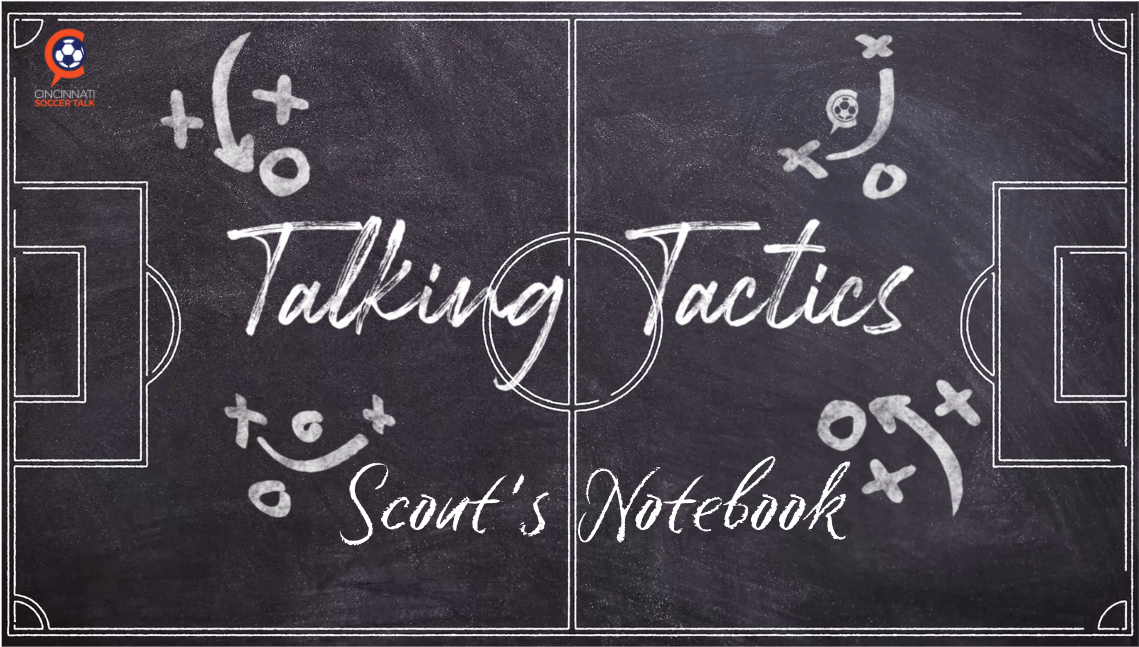Each week on The Walkthrough, Nate Gilman and I give you a high-level look at key tactical ideas for the upcoming match. To come up with those ideas, I watch at least two recent matches and compile the type of scouting report that I would have had for an opponent when I was coaching. This week’s opponent, the Philadelphia Union, comes into TQL Stadium riding the struggle bus. However, they are still the team that many experts picked as MLS Cup favorites this year.
For more soccer content like this, follow me on Twitter (@FCCincyTacTalk).
Team: Philadelphia Union
Matches Scouted: 3/20/23 vs Sporting Kansas City and 3/13/23 at Orlando City
Formation: 4-1-2-1-2 (commonly referred to as the 4-4-2 Diamond)
Mode of Attack
The Union aren’t just a counter-attacking group of long-ball merchants. They want to build out of the back, working to pull the opposition’s outside defender forward so that they can get the ball to a striker dropping into the half-space in the midfield (usually Julian Carranza) or play a through ball into the channel for a forward stretching in behind the opponent’s back line (usually Mikael Uhre). However, they don’t take chances while they build, so they will dump the ball long and try to counter-press and win second balls when they are put under pressure.
Method of Chance Creation
Once the Union have possession in the final third, they like to attack using wide overloads. They will have one of their shuttlers (the “side” players in the midfield diamond), their outside back and their attacking central midfielder in the same area wide on the pitch. Often their players will cycle in and out of each other’s positions from there, with the shuttler coming inside, the attacking midfielder running into the channel and the outside back overlapping. Because they do this in wide areas, it often leads to crosses or shots from distance.
Mode of Defense
Philadelphia will press high at times, but this hasn’t been their default this season (especially while balancing the CONCACAF Champions League). Instead, they like to drop into a mid-block, using their front 3 to funnel the ball wide. Then, they will try to press that wide player into mistakes.
Within this system, they typically have all of their midfielders on one side of the pitch. Therefore, the shuttlers are responsible for covering A LOT of ground, from the center of the pitch all the way to the wide areas. They squeeze their opponents and try to make it difficult for them to break lines or switch fields.
Mode of Transition
Offensively, when they aren’t building from the back, the Union often transition by dumping the ball into the channel and try to get out and run. They will have one forward check short and the other run the channel, attempting to catch the opponent’s center backs in between pressing and dropping.
Defensively, they press high and hard when they turn the ball over. This often leads to winning the ball or fouling to slow the opponent’s progression.
Major Strengths
- They are highly organized structurally and leave very little space for their opponent’s to create when in sustained possession.
- Their central defenders are fantastic positionally and rarely get beat in behind, even in the channels.
- Central defender Jakob Glesnes is very adept at breaking lines on the dribble. He will carry the ball forward, make his opponent commit to stop the ball and then play the ball by them, creating mini-transition opportunities.
- They have many players that can strike a shot from distance.
Vulnerabilities
- Because of the way their midfield diamond shifts to the ball side, they are susceptible to leaving space on the weak side if the opponent can switch the ball quickly.
- Because they typically play with a single pivot, they leave a lot of space in the hole (the gap between the midfield line and back line) in transition if their opponent can transition quickly.












